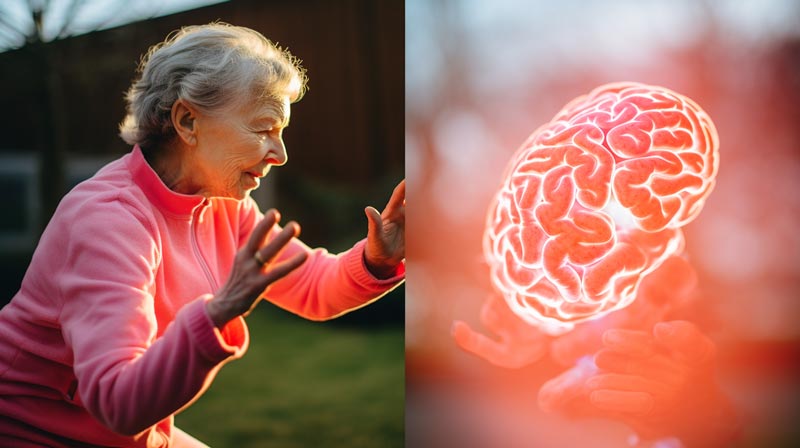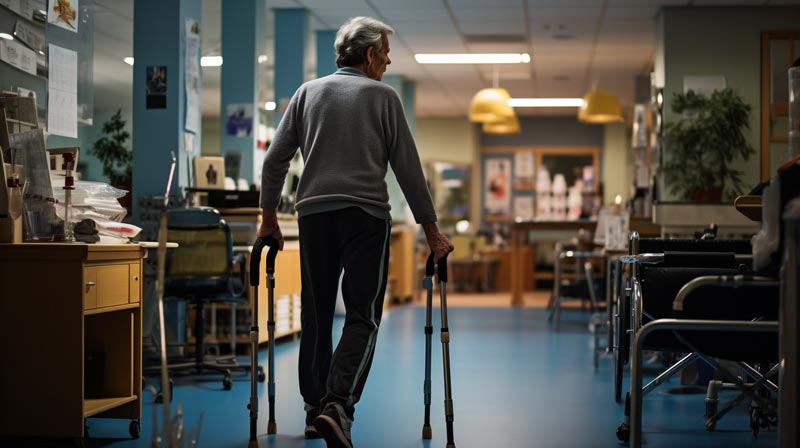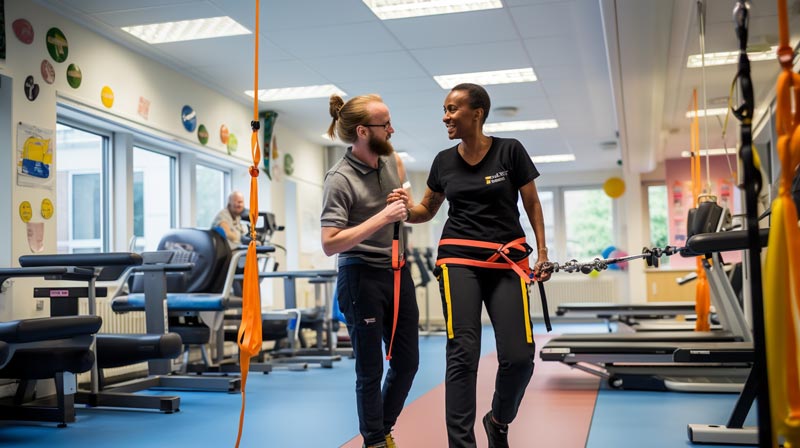By BeSund Editorial Team 11/07/2023 Modified Date: 03/05/2024
Stroke
Discover the role of exercise in stroke prevention and recovery
Stroke and Physical Recovery

Understanding Stroke and Physical Recovery
Stroke and Physical Recovery is a pressing subject that necessitates immediate discussion. Stroke, also known as cerebrovascular accident (CVA), is a leading cause of death and disability, affecting many physical and cognitive functions. High blood pressure and tobacco use are significant modifiable risks.
Core health behaviours like smoking, diet, and physical activity are pivotal in cardiovascular health. They are closely linked with stroke and its recovery. Exercise is an indispensable management tool for stroke, reducing the risk by over 25% when engaged moderately for at least 150 minutes per week.
The long-term effects of stroke, such as paralysis and cognitive issues, often require significant lifestyle modifications. Sedentary behaviour following a stroke elevates the risk of recurrent episodes and other cardiac problems. Aerobic exercise can mitigate this risk by nearly 30%.
Secondary complications like cognitive and mobility issues increase the financial burden of treating stroke. Exercise proves effective in addressing both physical and psychosocial post-stroke recovery challenges. Increased physical activity after a stroke is correlated with improved cognitive performance, emphasising exercise’s role in comprehensive rehabilitation.
This article will explore various dimensions of stroke and physical recovery. We will scrutinise the impact of stroke on physical performance, the role of exercise as a management tool, recommended exercises, safety measures, and lifestyle tips for coping with stroke aftermath.
Below, we turn our attention to global mortality trends to better understand the statistical impact of stroke and its bearing on physical recovery.
Global Mortality Trends: A Focus on Stroke and Physical Recovery
Stroke is the second leading cause of death worldwide, accounting for 6.7 million fatalities. A meta-analysis of 13 studies found that higher-intensity physical activity reduced stroke risk by 19%. Interestingly, men and women showed different risk reductions based on activity intensity. This sets the stage for a closer look at global mortality trends related to stroke and physical recovery.
The interactive stacked bar chart from the WHO mortality database provides a comprehensive view of global mortality trends from 1950 to now. Total deaths have soared from 3.2 million to 38.5 million, posing a growing challenge in global healthcare. Stroke and physical recovery remain critical, with stroke-related deaths increasing from about 211,170 to 3.9 million.
In the first plot, the percentage of deaths due to strokes fluctuates, suggesting varying healthcare effectiveness in stroke and physical recovery over the years.
The second plot reveals higher male mortality rates compared to females. Male deaths range from 1.6 million to 20.1 million, while female deaths range from 1.5 million to 18.5 million. This raises questions about gender-specific healthcare needs.
The third plot zeroes in on stroke deaths among males and females. Female stroke deaths outnumber male stroke deaths, highlighting an acute concern for stroke and physical recovery among females. This calls for gender-specific medical interventions.
The Impact of Stroke on Physical Performance
Stroke and physical recovery are closely linked, as stroke survivors face many physical challenges. One of the most immediate impacts is hemiplegia, which severely affects balance, coordination, and mobility. This condition leads to muscle wasting and spasticity over time.
Due to these physical limitations, stroke survivors typically have less than 50% of the aerobic capacity, strength, and function compared to age-matched healthy individuals. This results in difficulty with daily activities and an increased risk of falls and injuries. Below is a list of possible areas that may be impacted.
1. Physical Constraints and Secondary Problems
Stroke survivors often experience secondary problems, particularly with mobility and balance. These issues directly affect one’s ability to engage in physical activities. Moreover, walking for stroke survivors requires twice the energy compared to healthy adults.
2. Cognitive and Psychological Impacts
Increased physical activity, post-stroke can improve cognitive performance, although the assessment tools used in studies are generally suboptimal. Emotional difficulties like depression and anxiety are also common after a stroke, further complicating physical recovery.
3. Multidimensional Consequences
The multidimensional consequences of stroke include a range of physical, cognitive, and psychological impairments. Over half of long-term stroke survivors report ongoing mobility, fatigue, and concentration issues that persist for years.
4. Cardiovascular and Endurance Issues
Cardiorespiratory fitness shows a 10-20% reduction versus healthy controls after a stroke. This is accompanied by impaired oxygen uptake and premature fatigue during exertion, further hindering physical capabilities.

Exercise as a Management Tool for Stroke
Exercise is pivotal in stroke recovery, offering benefits that span motor skills, cardiovascular health, and overall well-being. The timing for initiating exercise post-stroke is nuanced, varying according to specific recovery phases. These phases are crucial in determining the type and intensity of exercise, and they evolve from immediate post-stroke care to long-term maintenance.
- Immediate Post-Stroke: Medical stabilisation takes precedence, and exercise is generally not recommended.
- Acute Phase: Light exercise and mobility work may commence within the first few days to weeks, always under professional supervision to prevent complications like muscle atrophy.
- Subacute Phase: From 1–6 months post-stroke, exercise regimens become more structured, focusing on functional ability and combating complications like spasticity.
- Chronic Phase: Beyond 6 months, the focus shifts to long-term recovery and maintenance, allowing for more rigorous exercise programmes.
Regular physical activity is a cornerstone in managing stroke and physical recovery. Exercise can reduce your risk of stroke or transient ischaemic attack (TIA) by over 25%. It also offers physical and mental health benefits, including lowering blood pressure and cholesterol levels.
The subsequent discussion outlines specific types of physical activity exercises and their respective benefits for stroke survivors.
Exercise Types and Their Benefits
Aerobic and resistance training are safe and effective in improving cardiovascular health and reducing disability in stroke survivors. Aerobic training alone can improve fitness levels by 10-25% compared to non-exercise controls. Supported treadmill training has shown to be superior to outdoor walking. In contrast, resistance training enhances muscle power, which is crucial for daily function.
Comprehensive Exercise Benefits for Stroke and Physical Recovery
Various exercise forms, including aerobic, strength, and flexibility exercises, positively impact stroke patients, improving everything from aerobic fitness to cognitive abilities.
Physical Functioning and Psychological Benefits
Regular exercise post-stroke improves muscle strength in weak limbs and enhances balance and coordination. It also offers psychological benefits like improved mood.
Risk Reduction and Recurrence
Moderate to vigorous physical activity can reduce first-time and recurrent stroke risk by up to 25%.
Addressing Post-Stroke Problems
Exercise helps manage common post-stroke issues by improving physical fitness and function. Physical activity could enhance cardiorespiratory fitness, muscle strength, and overall process.
Long-Term Functional Gains
Exercise provides a valuable tool to counteract the physical deconditioning and functional impairments resulting from stroke.
Recommended Exercises for Stroke and Physical Recovery
The role of exercise in stroke and physical recovery is multifaceted, offering a range of options tailored to individual needs and conditions. Various factors influence exercise choice, including personal interests, physical abilities, and local availability.
To better understand the exercise options beneficial for stroke and physical recovery, we’ll examine different modalities, scrutinise their efficacy, and discuss how to customise them to individual needs.
Aerobic Exercises for Stroke Recovery
Aerobic exercises like biking and swimming are often recommended over treadmill walking due to a lower risk of falls. This is particularly crucial for stroke survivors who may have compromised balance and coordination.
In addition to reducing the risk of falls, aerobic exercises enhance cardiovascular health, a crucial element in stroke recovery. Moreover, these exercises can significantly improve endurance, essential for performing daily activities and regaining independence post-stroke.

Resistance Training for Stroke and Physical Recovery
Resistance training, particularly when supervised, has been shown to significantly improve strength and overall function. This exercise is not just about muscle building; it’s about restoring functional ability, often compromised after a stroke.
Incorporating resistance training into your stroke recovery regimen can offer long-term benefits, including improved muscle tone and function. This is particularly beneficial for those who may have experienced muscle atrophy or weakness following a stroke.
Water-Based Exercises
Water-based exercises offer advantages in mobility and spasticity reduction compared to land-based training. The buoyancy of water provides a safe environment for stroke recovery exercises, reducing the risk of injury.
Moreover, water-based exercises can particularly benefit those with severe mobility restrictions. The water’s buoyancy supports the body, allowing for a more excellent range of motion and providing a medium for resistance training.
Virtual Reality and Comprehensive Benefits
A holistic approach to exercise, incorporating virtual reality systems, offers an engaging alternative for those with limited mobility. This approach has been shown to improve the physical and psychosocial aspects of post-stroke life.
Virtual reality provides an interactive platform that can simulate real-world activities, making rehabilitation more engaging and potentially more effective.
Tailored Exercise Recommendations for Stroke and Physical Recovery
All exercise regimens should be customised to the individual’s abilities and needs, ideally under the guidance of a healthcare professional. A combination of cardiorespiratory and resistance training is often recommended.
Customisation is critical in stroke recovery. Exercise plans should be adapted to each individual’s physical condition, considering potential limitations or complications.
The FITT Framework
Experts advocate for structured exercise programs that adhere to the FITT principles: Frequency, Intensity, Time, and Type. This framework ensures that each exercise component is tailored to the individual’s impairments and goals.
1. Aerobic
- Frequency: 3-5 days per week
- Intensity: 40-70% HRR or 11-14 RPE
- Time: 20 to 60 minutes
- Type: Cycle, treadmill with harness if needed
2. Resistance
- Frequency: 2 non-consecutive days per week
- Intensity: 50-70% 1RM
- Time: 1-3 sets of 8-15 reps
- Type: Weights or machines
3. Flexibility
- Frequency: ≥2-3 days per week
- Intensity: Stretch until you feel tightness
- Time: 10-30 sec holds, 2-4 reps
- Type: Static, PNF (Proprioceptive Neuromuscular Facilitation), dynamic stretches
4. Balance
- Frequency: 3-5 days per week
- Intensity: Exercises challenging but not exceeding ability
- Time: 10-20 minutes
- Type: Static and dynamic balance activities
Observing these guidelines allows exercise programs to be tailored to each individual’s capabilities, optimising stroke and physical recovery benefits.
Safety Measures and Precautions for Exercising with Stroke
In stroke recovery, exercise is not just a supplementary activity but a critical component of a well-rounded rehabilitation strategy. It serves as a powerful catalyst for enhancing physical and cognitive functions, helping to accelerate recovery and improve quality of life.
However, incorporating exercise into a stroke recovery plan is a complex undertaking that requires nuanced understanding and expertise. It’s about targeted, individualised interventions considering stroke recovery’s unique challenges and risks.
Exercise must be approached with meticulous planning, medical oversight, and a deep understanding of the patient’s condition and limitations. The Valsalva manoeuvre, for instance, should be avoided to prevent excessive blood pressure spikes.
Below are safety measures and precautions grounded in established guidelines and research to facilitate Stroke and Physical Recovery.
1. Initial Medical Consultation
Before embarking on any exercise regimen, consult your GP, especially if you’ve been inactive. Medication side effects can also influence your exercise choices.
2. Supervision and Monitoring
Supervision during exercise is non-negotiable for stroke patients. Monitoring exertion levels and having a spotter can prevent adverse events.
3. Gradual Transitions
Start at lower aerobic intensities (~40% HRR) and build up gradually. This approach minimises the risk of overexertion and allows for better exercise tolerance.
4. Adaptation for Physical Limitations
Adapting exercises to accommodate hemiparesis or spasticity is crucial. Tailored activities reduce the risk of injury.
5. Hydration and Medication
Staying hydrated aids in thermoregulation, but be cautious of medication side effects that may interfere with exercise.
6. Warning Signs
Education on warning signs like chest pain and dizziness can prevent severe complications.
7. Equipment and Environment
Choose low-impact equipment and ensure the exercise space is free from hazards. Assistive devices can be used for weak limbs.
8. Emergency Protocols
Have an emergency response plan and a first-aid kit readily available.
9. Regular Reviews
The condition of a stroke patient can change; regular reviews are essential for making necessary adjustments to the exercise plan.
This is still ongoing, but they offer a great start. Exercise can benefit stroke recovery and management by following these safety measures and precautions. Proper planning, constant supervision, and adaptability are essential.

Living with Stroke and Physical Recovery: Fitness Tips
Living with stroke involves a complex path towards Stroke and Physical Recovery, where exercise is vital. It’s not a supplementary activity but a critical part of a comprehensive rehabilitation strategy. This strategy should be tailored to each individual’s medical history, current health status, and unique challenges.
Working with healthcare providers is essential for creating a safe and effective exercise programme. A well-rounded approach, incorporating aerobic and resistance training, is strongly advised. This improves physical capabilities and enhances mental well-being, contributing to a more robust recovery process.
The road to recovery is fraught with challenges, including motivational barriers and self-doubt. Tackling these issues requires a holistic approach that combines education, real-time feedback, and a robust social support network. Community-based programmes can offer this multi-layered support, making exercise a sustainable part of long-term recovery.
Actionable Fitness and Lifestyle Tips for Stroke Survivors:
- Incrementally increase exercise intensity, including rest days, to mitigate the risk of overtraining.
- Employ adaptive equipment and monitor vital signs and hydration levels during workouts.
- Establish realistic, progressive goals, such as extending your walking time by five minutes daily.
- Use fitness trackers to keep tabs on your progress and maintain motivation.
- Engage in social exercise activities, either with family or through community group classes.
- Observe a balanced diet rich in nutrients and stay well-hydrated.
- Prioritise sleep and employ stress management techniques for a well-rounded recovery.
Following these guidelines consistently can substantially lower stroke recurrence risk and elevate overall quality of life.
Exercise becomes an indispensable asset for long-term stroke recovery and physical wellness when executed with meticulous planning and medical oversight.
Sources
- American Heart Association. Hemiparesis.
- Billinger SA, Arena R, Bernhardt J, Eng JJ, Franklin BA, Johnson CM, MacKay-Lyons M, Macko RF, Mead GE, Roth EJ, Shaughnessy M, Tang A; American Heart Association Stroke Council; Council on Cardiovascular and Stroke Nursing; Council on Lifestyle and Cardiometabolic Health; Council on Epidemiology and Prevention; Council on Clinical Cardiology. Physical activity and exercise recommendations for stroke survivors: a statement for healthcare professionals from the American Heart Association/American Stroke Association. Stroke. 2014 Aug;45(8):2532-53.
- Caspersen CJ, Powell KE, Christenson GM. Physical activity, exercise, and physical fitness: definitions and distinctions for health-related research. Public Health Rep. 1985 Mar-Apr;100(2):126-31. PMID: 3920711; PMCID: PMC1424733.
- Cumming TB, Tyedin K, Churilov L, Morris ME, Bernhardt J. The effect of physical activity on cognitive function after stroke: a systematic review. Int Psychogeriatr. 2012 Apr;24(4):557-67.
- Danielsson A, Willén C, Sunnerhagen KS. Measurement of energy cost by the physiological cost index in walking after stroke. Arch Phys Med Rehabil. 2007 Oct;88(10):1298-303.
- Diep L, Kwagyan J, Kurantsin-Mills J, Weir R, Jayam-Trouth A. Association of physical activity level and stroke outcomes in men and women: a meta-analysis. J Womens Health (Larchmt). 2010 Oct;19(10):1815-22.
- Ferguson B. ACSM’s Guidelines for Exercise Testing and Prescription 9th Ed. 2014. J Can Chiropr Assoc. 2014 Sep;58(3):328. PMCID: PMC4139760.
- Globas C, Becker C, Cerny J, Lam JM, Lindemann U, Forrester LW, Macko RF, Luft AR. Chronic stroke survivors benefit from high-intensity aerobic treadmill exercise: a randomised control trial. Neurorehabil Neural Repair. 2012 Jan;26(1):85-95.
- Han, P. et al. (2017). Clinical Evidence of Exercise Benefits for Stroke. In: Xiao, J. (eds) Exercise for Cardiovascular Disease Prevention and Treatment. Advances in Experimental Medicine and Biology, vol 1000. Springer, Singapore.
- Harris JE, Eng JJ. Strength training improves upper-limb function in individuals with stroke: a meta-analysis. Stroke. 2010 Jan;41(1):136-40.
- Hu G, Tuomilehto J, Silventoinen K, Barengo N, Jousilahti P. Joint effects of physical activity, body mass index, waist circumference and waist-to-hip ratio with the risk of cardiovascular disease among middle-aged Finnish men and women. Eur Heart J. 2004 Dec;25(24):2212-9.
- Kiely DK, Wolf PA, Cupples LA, Beiser AS, Kannel WB. Physical activity and stroke risk: the Framingham Study. Am J Epidemiol. 1994 Oct 1;140(7):608-20. Erratum in: Am J Epidemiol 1995 Jan 15;141(2):178. PMID: 7942761.
- Langhorne P, Wu O, Rodgers H, Ashburn A, Bernhardt J. A Very Early Rehabilitation Trial after stroke (AVERT): a Phase III, multicentre, randomised controlled trial. Health Technol Assess. 2017 Sep;21(54):1-120.
- Lloréns R, Noé E, Colomer C, Alcañiz M. Effectiveness, usability, and cost-benefit of a virtual reality-based telerehabilitation program for balance recovery after stroke: a randomised controlled trial. Arch Phys Med Rehabil. 2015 Mar;96(3):418-425.e2.
- McKevitt C, Fudge N, Redfern J, Sheldenkar A, Crichton S, Rudd AR, Forster A, Young J, Nazareth I, Silver LE, Rothwell PM, Wolfe CD. Self-reported long-term needs after stroke. Stroke. 2011 May;42(5):1398-403.
- Mehrholz J, Thomas S, Kugler J, Pohl M, Elsner B. Electromechanical-assisted training for walking after stroke. Cochrane Database Syst Rev. 2020 Oct 22;10(10):CD006185.
- Ouellette MM, LeBrasseur NK, Bean JF, Phillips E, Stein J, Frontera WR, Fielding RA. High-intensity resistance training improves muscle strength, self-reported function, and disability in long-term stroke survivors. Stroke. 2004 Jun;35(6):1404-9.
- Mussolino ME, Navaneethan SD, Parikh NI, Poudel R, Rezk-Hanna M, Roth GA, Shah NS, St-Onge MP, Thacker EL, Virani SS, Voeks JH, Wang NY, Wong ND, Wong SS, Yaffe K, Martin SS; American Heart Association Council on Epidemiology and Prevention Statistics Committee and Stroke Statistics Subcommittee. Heart Disease and Stroke Statistics-2023 Update: A Report From the American Heart Association. Circulation. 2023 Feb 21;147(8):e93-e621.
- Pang MY, Eng JJ, Dawson AS, McKay HA, Harris JE. A community-based fitness and mobility exercise program for older adults with chronic stroke: a randomised, controlled trial. J Am Geriatr Soc. 2005 Oct;53(10):1667-74.
- Ryan AS, Dobrovolny CL, Smith GV, Silver KH, Macko RF. Hemiparetic muscle atrophy and increased intramuscular fat in stroke patients. Arch Phys Med Rehabil. 2002 Dec;83(12):1703-7.
- Ronai, Peter MS, RCEP, CSCS*D, NSCA-CPT*D, CSPS1; Sorace, Paul MS, RCEP, CSCS*D2. Exercise and Stroke. Strength and Conditioning Journal 37(1):p 50-55, February 2015.
- Saunders DH, Greig CA, Mead GE. Physical activity and exercise after stroke: review of multiple meaningful benefits. Stroke. 2014 Dec;45(12):3742-7.
- Smith AC, Saunders DH, Mead G. Cardiorespiratory fitness after stroke: a systematic review. Int J Stroke. 2012 Aug;7(6):499-510.
- Stroke Association. November 2017. Exercise and Stroke. Version 2. Item code: A01R07.
- Tsao CW, Aday AW, Almarzooq ZI, Anderson CAM, Arora P, Avery CL, Baker-Smith CM, Beaton AZ, Boehme AK, Buxton AE, Commodore-Mensah Y, Elkind MSV, Evenson KR, Eze-Nliam C, Fugar S, Generoso G, Heard DG, Hiremath S, Ho JE, Kalani R, Kazi DS, Ko D, Levine DA, Liu J, Ma J, Magnani JW, Michos ED, Mussolino ME, Navaneethan SD, Parikh NI, Poudel R, Rezk-Hanna M, Roth GA, Shah NS, St-Onge MP, Thacker EL, Virani SS, Voeks JH, Wang NY, Wong ND, Wong SS, Yaffe K, Martin SS; American Heart Association Council on Epidemiology and Prevention Statistics Committee and Stroke Statistics Subcommittee. Heart Disease and Stroke Statistics-2023 Update: A Report From the American Heart Association. Circulation. 2023 Feb 21;147(8):e93-e621.
- Tyson SF, Connell LA, Lennon S, Busse ME. What treatment packages do UK physiotherapists use to treat postural control and mobility problems after stroke?. Disabil Rehabil. 2009;31(18):1494-500.
- US Department of Health and Human Services. Physical activity and health. A report of the Surgeon General: US Department of Health and Human Services, Centers for Disease Control and Prevention, National Center for Chronic Disease Prevention and Health Promotion. 1996:85–172.
- World Health Organization. ‘Stroke, Cerebrovascular Accident’.
- World Health Organization. The Top 10 Causes of Death. Geneva (Switzerland): World Health Organization.


